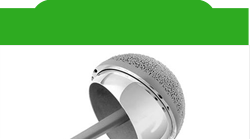Press Room
Dr. Su responds to the recent Lancet article
I would like to take this opportunity to comment on the Lancet article, “Failure rates of metal-on-metal hip resurfacings: analysis of data from the National Joint Registry for England and Wales”, by Professor AW Blom, published on October 2, 2012.
First of all, this is an observational scientific study with valid research design and questions; however, the conclusions point out the limitations of registry studies (more on this to follow). Overall the conclusions of the study do NOT find any new information that has not already been known since 2010: that certain hip resurfacing implants perform better than others; that females do worse than males with hip resurfacing; and that larger size implants have a lower revision rate. These key pieces of information have been well-known and discussed by experienced hip resurfacing surgeons with their patients for at least 2 years already. Furthermore, there are scientific congresses and courses that have help spread this information to surgeons, including the course that I chaired in May 2010.
What is new in this paper is the comparison to cemented, hybrid, and uncemented total hip replacements (THR) of various head sizes; the conclusion is that hip resurfacing has a higher revision rate than any of these methods of total hip replacement for most patients, and is not suitable for most patients. The data cited is that 5 year revision rates for 55 year old men was 2.6% with a 54mm hip resurfacing femoral head, and 1.9% with a 28mm cemented metal-on-polyethylene THR.
As this study was performed in the UK, I would like to point out that fully cemented THR is not often performed in the United States. In fact, it represents less than 5% of all THR done in this country, and is on the decline. So, these findings may not be applicable outside of the UK.
In looking at the data presented, there are actually some comparable rates of survival between hip resurfacing and the type of THR most commonly performed in the US. Namely, hip resurfacings with femoral head diameters of 50mm had a 5 year revision rate of 4.2%; 52mm was 3.77%, and 54mm was 3.37%. For hybrid THR with a 28mm head, the 5 year revision rate was 4.1%, and an uncemented THR was 4.18%. When divided by gender, the results for males are even better. Men aged 55 years with a resurfacing implant of 50mm had a 7 year revision rate of 3.27%; a 54mm head diameter was 2.47%.
Limitations of registry studies
The problem with a registry is that it collects a little bit of information about a lot of people. Therefore, the outcome measure that Professor Blom uses, revision rate, is a crude indicator of how the implant is performing. Revision rate will only include those patients who undergo a second, or revision operation. It does not include those patients who have had dislocations of their hip, or thigh pain, as many of these patients will not have revision surgery for these problems. It is an established fact that the dislocation rate after hip resurfacing is about 10x lower than for THR; thus the registry is not able to capture all the THR patients who have had a complication such as dislocation or thigh pain from the stem of the implant. Therefore the reported superiority of THR has only to do with revision, and does not include complications.
Besides a complication such as dislocation, the registry does not have clinical information about how the patients are functioning. Are the hip resurfacing patients participating in more activities? Are they more satisfied with their hips? Is their range of motion superior? Who has a more normal gait? The registry is not able to answer these questions – if a hip operation gave superior function, some patients would consider it a worthwhile operation despite the slightly higher risk of revision. There have been several studies that demonstrate that hip resurfacing patients are more active and have a higher satisfaction rate than their THR counterparts.
Finally, a registry study is not able to account for surgeon practices with regard to revision surgery. There is a particular type of knee replacement, called a hinged knee, that has a 100% survivorship in a national joint registry. However, this is because there is no revision possible for this type of implant – it simply cannot be revised because it is an implant done for “last-resort” situations. Therefore, in looking at the registry results, one could conclude that this is the best implant available, a conclusion that is clearly erroneous. What this registry is unable to adjust for is the likelihood of revision based on the type of implant. I can tell you from experience that revising a hip resurfacing is the easiest revision to perform; next is an uncemented or hybrid THR; and hardest to revise is a cemented THR (because the parts are not easily exchanged). Therefore, the registry results may be reflective of the tendency for surgeons to indicate the easiest type of revision operation.
Conclusion
I believe that there is valuable information from this study, one that highlights the importance of patient selection for hip resurfacing. However, I don’t feel that it provides the entire picture of comparing patient activity, function, and complications between the two procedures. I also look to other international studies, particularly the Australian National Joint Registry. Their 2012 report demonstrates a revision rate of 4.2% at 7 years, for men younger than 55 years who had hip resurfacing; their THR counterparts had a 7 year revision rate of 4.6%. Thus, in this patient population, hip resurfacing has a lower 7 year revision rate as compared to total hip replacement.
The study by Blom et al. fails to account for the countless lives that have been returned to one of function and activity by hip resurfacing, which is why I don’t agree with the recommendation of denying my patients this alternative to total hip replacement.
The Center for Hip Pain & Preservation
541 East 71st Street
New York, NY 10021
 Click here for Driving Directions
Click here for Driving Directions

















